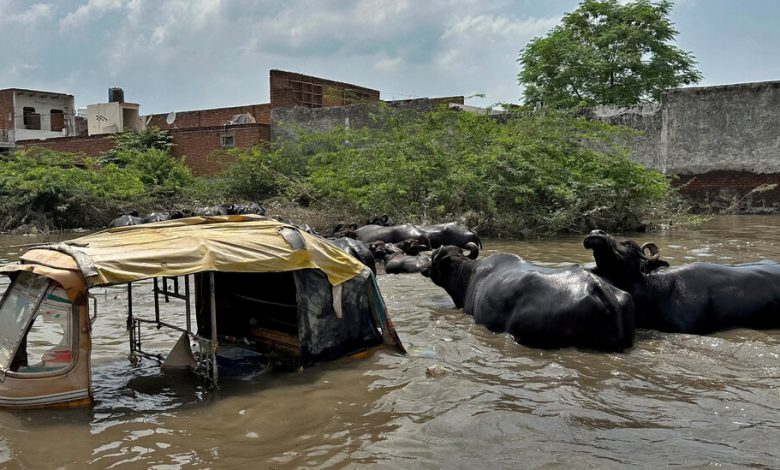Around the Globe, Searing Heat With No Sign of Relief

The intense heat afflicting much of the United States is putting pressure on the nation’s power grid. Record-high temperatures are being recorded in China and Europe. Extreme weather has been wracking India, where torrential rains led to deadly landslides this week.
And there is little relief in sight.
On Thursday, a day after the National Oceanic and Atmospheric Administration said last month was the planet’s warmest June since global temperature record-keeping began in 1850, its forecasters said August was unlikely to bring any respite, at least in the United States. The agency is predicting unusually high temperatures in most of the country next month, almost everywhere except the northern Great Plains.
Late Thursday, the operator of California’s power grid issued an emergency alert urging people to conserve electricity, as high temperatures put unusual strain on the system. In Phoenix, the temperature hit 116 degrees on Thursday, extending the city’s record streak to 21 straight days with temperatures of 110 degrees or higher.
The first two weeks of July were likely the Earth’s warmest on record for any time of year, according to the European Union’s Copernicus Climate Change Service.
Some scientists have suggested that last month’s heat wave was made five times as likely and 5 degrees Fahrenheit hotter than it would have been without climate change. Although heat waves happen naturally, the sheer heights of June’s temperatures around the globe were very unlikely to have occurred without global warming, said John Nielsen-Gammon, director of the Southern Regional Climate Center.
In Asia, extremely high temperatures have accompanied an intense monsoon season that has already taken more than 100 lives in India, South Korea and Japan, with the full death toll likely to be considerably higher.
In India, intense heat has been replaced by severe rainfall in much of the country, particularly in the Himalayan states of Uttarakhand and Himachal Pradesh. The intense downpours have caused massive landslides and flash floods, killing at least 130 people in the past 26 days in northern India.
An April report by India’s government foreshadowed such problematic weather, warning that “with unchecked global warming, the probability of compound extremes such as the simultaneous occurrence of droughts and heat waves is also likely to increase.” Droughts can make flash floods more likely because soil becomes less absorbent.
Heat waves in India normally occur before the monsoon season, from March to June. But this year, temperatures have remained extremely high for far longer, reflecting a steady warming trend in recent years. While a temperature of 91 degrees or more was recorded, on average, 70 days a year between 1961 and 1990, between 1991 to 2022 there were an average of 89 days hitting that mark.
Much of China also continued to bake on Friday, as its heat wave shattered records across the country.
The far western region of Xinjiang has been particularly hard-hit. Temperatures on Sunday at a remote desert township hit 126 degrees, reportedly breaking the previous record for the highest temperature in China. Parts of Xinjiang were expected to keep seeing temperatures over 100 degrees, according to official media. The authorities also said they were on alert for potential wildfires in northern Xinjiang.
Late July is historically the hottest time of year in southern China, and officials there warned that high humidity would make temperatures feel almost 20 degrees hotter than the actual measurements.
China’s largest freshwater lake, Poyang Lake, entered its dry season on Thursday, the earliest start to the season since record-keeping began in the 1950s, according to the authorities in Jiangxi Province. They cited the continuous heat, as well as a lack of rainfall, as the reason for alarmingly low water levels.
In northern China, several cities, including Beijing, have broken records for the most days in a year above 95 degrees, although rainstorms that began Thursday night were expected to finally bring some relief.
But the storms brought their own concerns, as officials warned of potential flash floods around the capital. Two years ago, on July 20, 2021, the city of Zhengzhou, in central China, recorded what state media said was the most rainfall on record ever to fall in a single hour in the country, as downpours killed at least 300 people.
In the United States, forecasters said the current heat wave was expected to last through the weekend in the Deep South and Southeast and into next week for the Southwest. Nearly 80 million Americans are expected to experience temperatures above 105 in the next few days, the National Weather Service said.
More than a quarter of the U.S. population experienced dangerous heat on Thursday, according to a New York Times analysis of daily weather and population data.
Severe storms, particularly in the southeastern United States, have added to the toll that the heat has taken on energy supplies. Hundreds of thousands of people lost power as strong thunderstorms knocked out power lines; 150,000 homes were without electricity in Georgia, and in western Tennessee, 52,000 homes and businesses suffered from blackouts on Thursday.
In Europe, the searing temperatures have taken a particular toll on older people, with southern European nations being joined by others as far north as Belgium in putting heat plans in place, many aimed at safeguarding older populations.
Extreme heat can be dangerous for anyone’s body, but older people and outdoor workers are at particular risk. Summer heat waves in Europe last year may have killed 61,000 people across the continent, according to a recent study.
This year’s heat and humidity have been particularly devastating in northern Mexico, where more than 100 people died of heat-related causes after a “heat dome” parked over the region, according to reports from the federal health ministry.
Heat domes are weather phenomena that form naturally from time to time. Some meteorologists and climate scientists believe that a warming Arctic is causing the jet stream to slow down, meaning that such weather systems stay longer in one place.
Mr. Nielsen-Gammon of the Southern Regional Climate Center said it was too soon to know whether that had happened in the case of the heat dome over Mexico and the southern United States.
Reporting was contributed by Suhasini Raj in New Delhi and Vivian Wang in Beijing. Li You contributed research from Shanghai.



